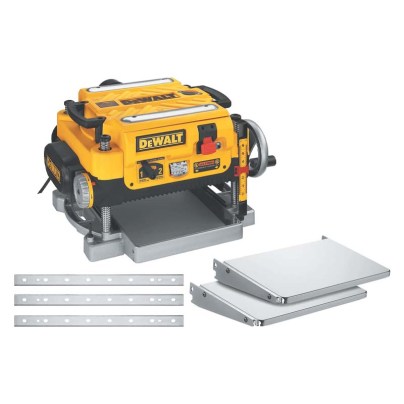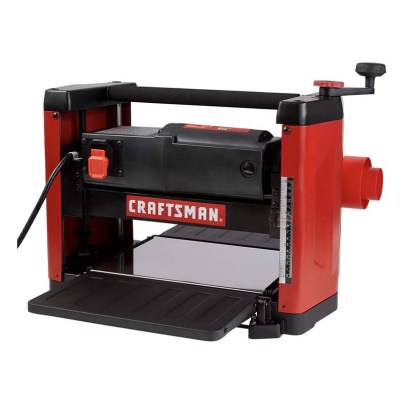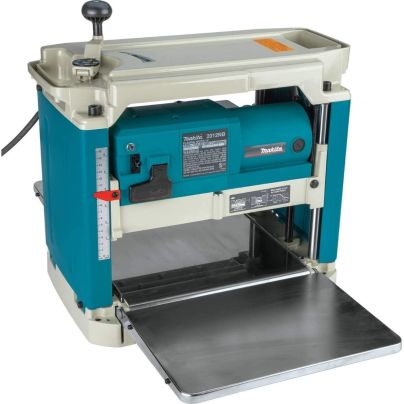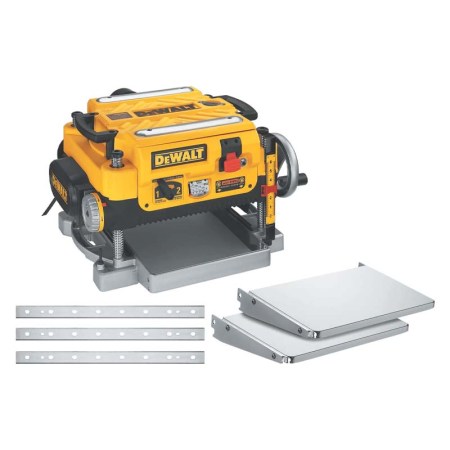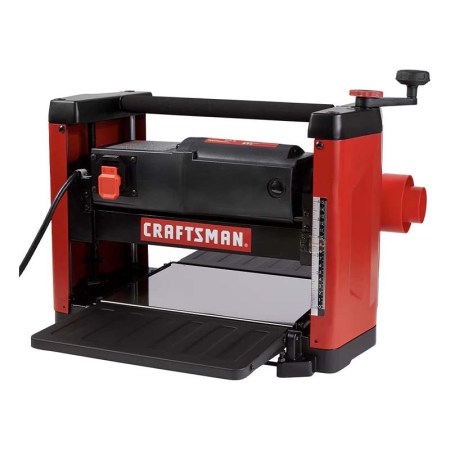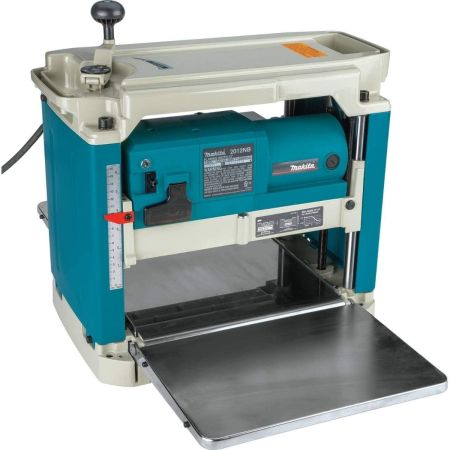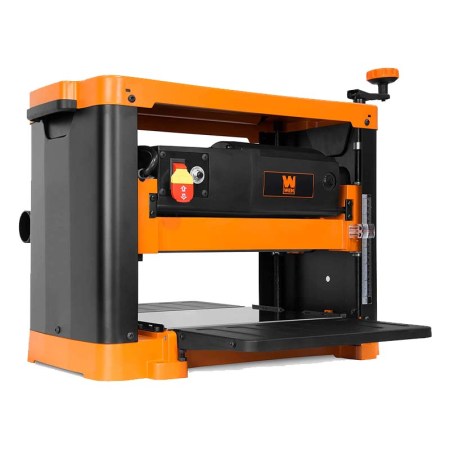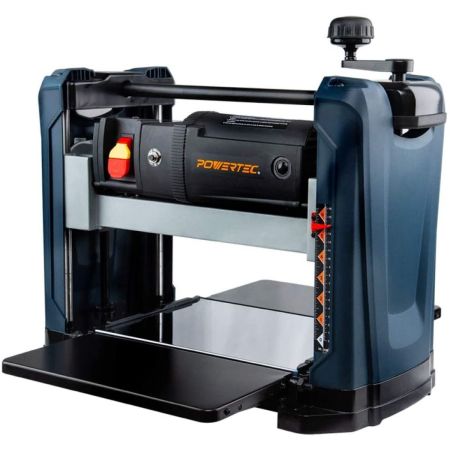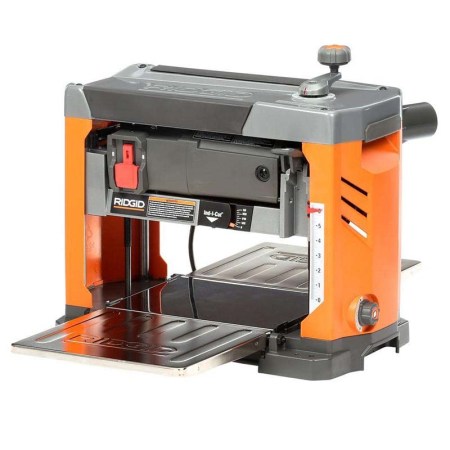We may earn revenue from the products available on this page and participate in affiliate programs. Learn More ›
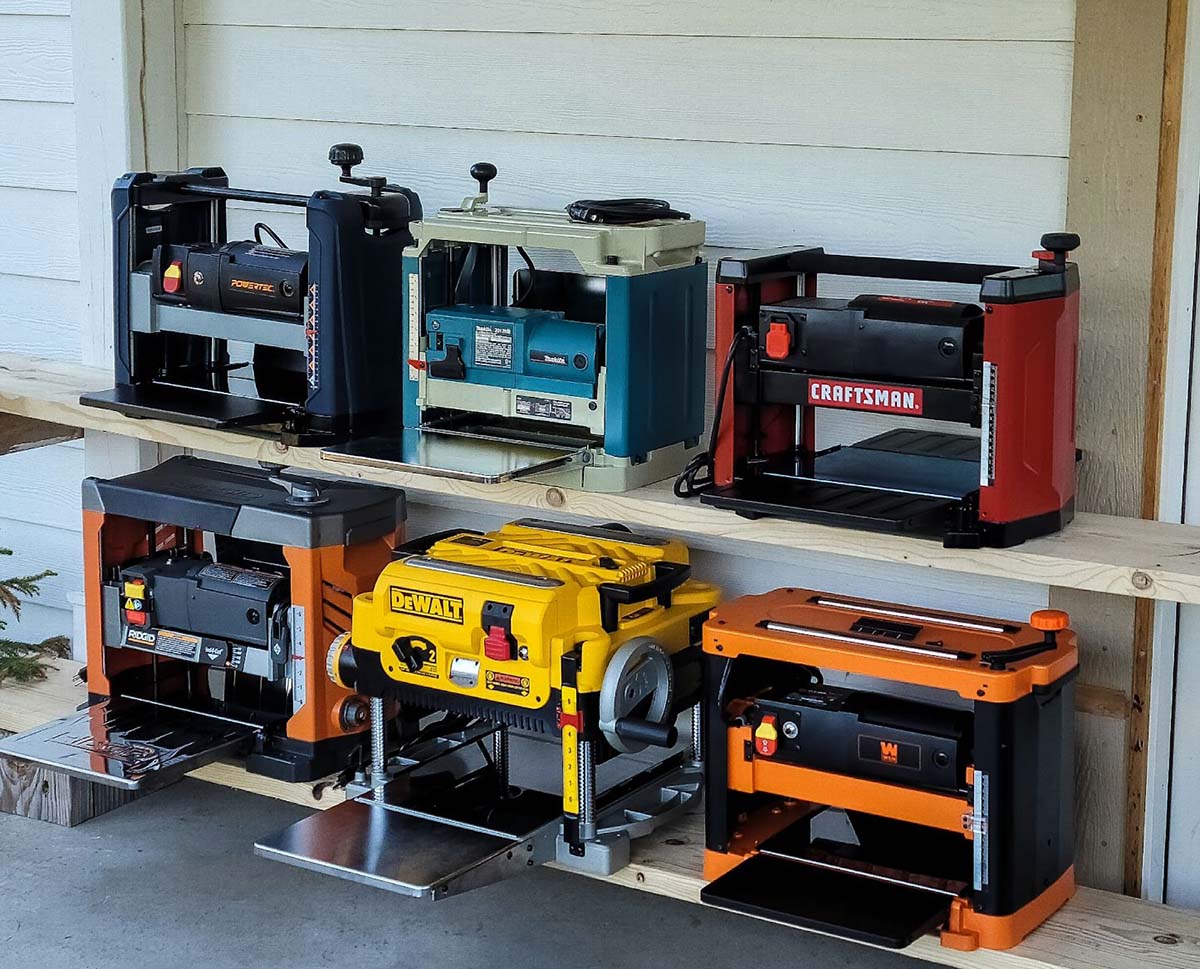
Benchtop planers—box-shaped power tools that reduce board thickness while smoothing the surface—top many a woodcrafter’s wish list. They fine-tune the wood used to create cabinets, bookshelves, and more, replacing old-fashioned hand planes because they’re much faster and easier to use.
Like our readers, we wanted to know which of today’s popular models perform well in real workshop situations, so we tested them. We selected highly rated benchtop planers and started planing boards—hundreds of ’em! We also reached out to Jay Sanders, licensed contractor and owner of Castle Dream Construction, a home remodeling company based in Baltimore, Maryland, to get his insights on what our readers will want to consider when shopping for one.
Keep reading to find out how the following models earned a spot in this lineup of the best benchtop planers for DIYers and seasoned woodworkers.
- BEST OVERALL: Dewalt 13-Inch 3-Knife 2-Speed Thickness Planer
- BEST BANG FOR THE BUCK: Craftsman 15 Amp Benchtop Thickness Planer
- UPGRADE PICK: Makita 2012NB 12- Inch Portable Planer
- BEST FOR ROUGH WOOD: Wen 12.5-Inch 2-Blade Benchtop Thickness Planer
- BEST LIGHT-DUTY: PowerTec PL1252 12.5-Inch Planer
- ALSO CONSIDER: Ridgid 13-Inch Thickness Planer w/ 3-Blade Cutterhead
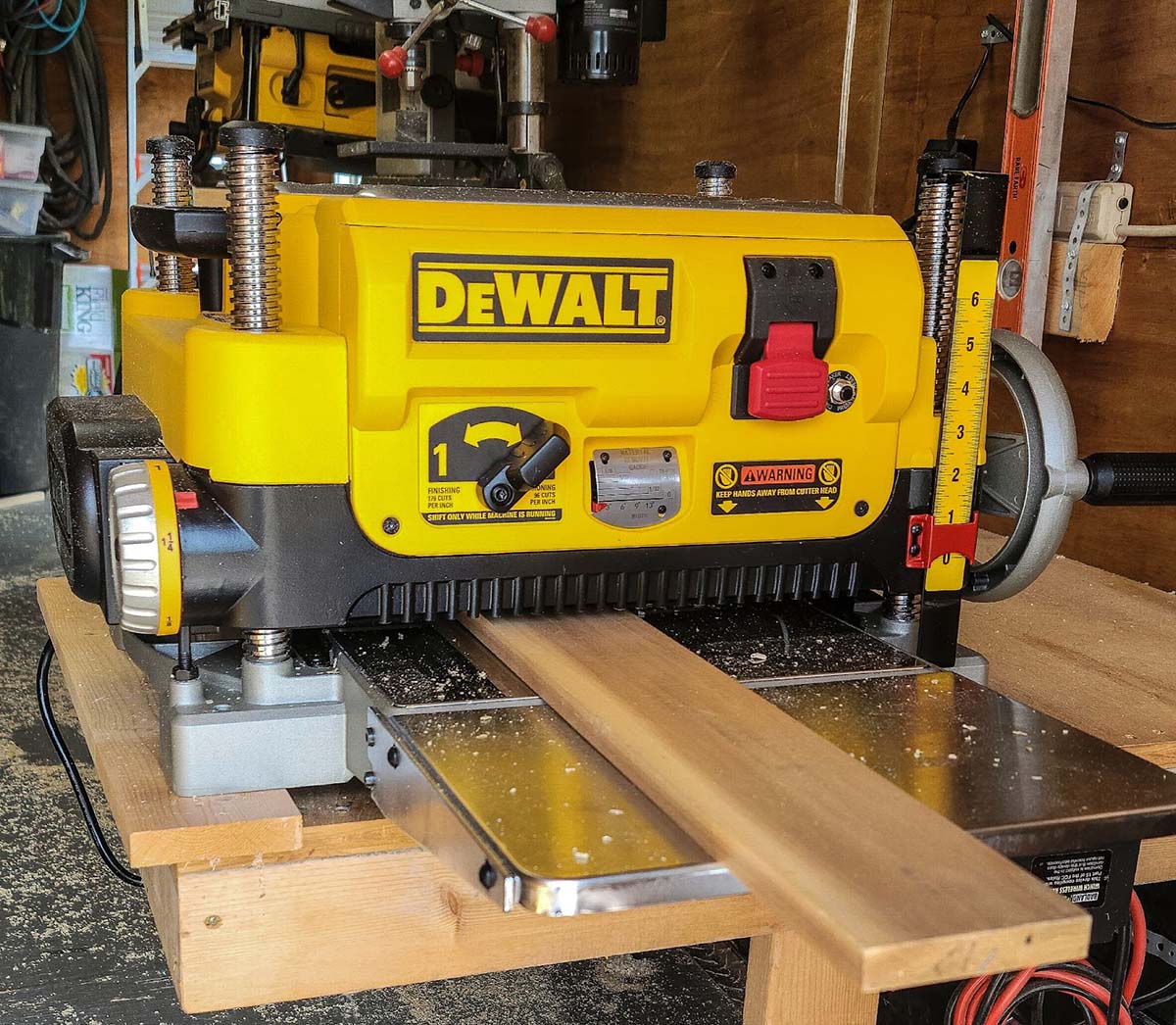
How We Tested the Best Benchtop Planers
When selecting the best benchtop planers, Sanders considers several factors, including cutterhead type, power, and whether the benchtop planer comes with a table that supports the boards. We looked at all of these factors during the selection process, plus we considered how well each planer rated with experienced users. We also considered the brand to an extent. After all, manufacturers such as DeWalt, Makita, and Craftsman have top-notch reputations in the power tool industry. We didn’t stick with just those three; we also included additional highly rated models from other manufacturers.
We unboxed and set up the benchtop planers according to manufacturer specifications. Then, we started planing new wood, reclaimed wood, softwood boards, and hardwood boards. We paid special attention to how smooth the planers left the board surfaces and whether the machines left snipes (unwanted cuts in the last few inches of the board).
We analyzed overall performance and ease of use and awarded points based on a rubric. The better a planer performed, the higher the points. After testing, we averaged the points to help determine the best category and intended use.
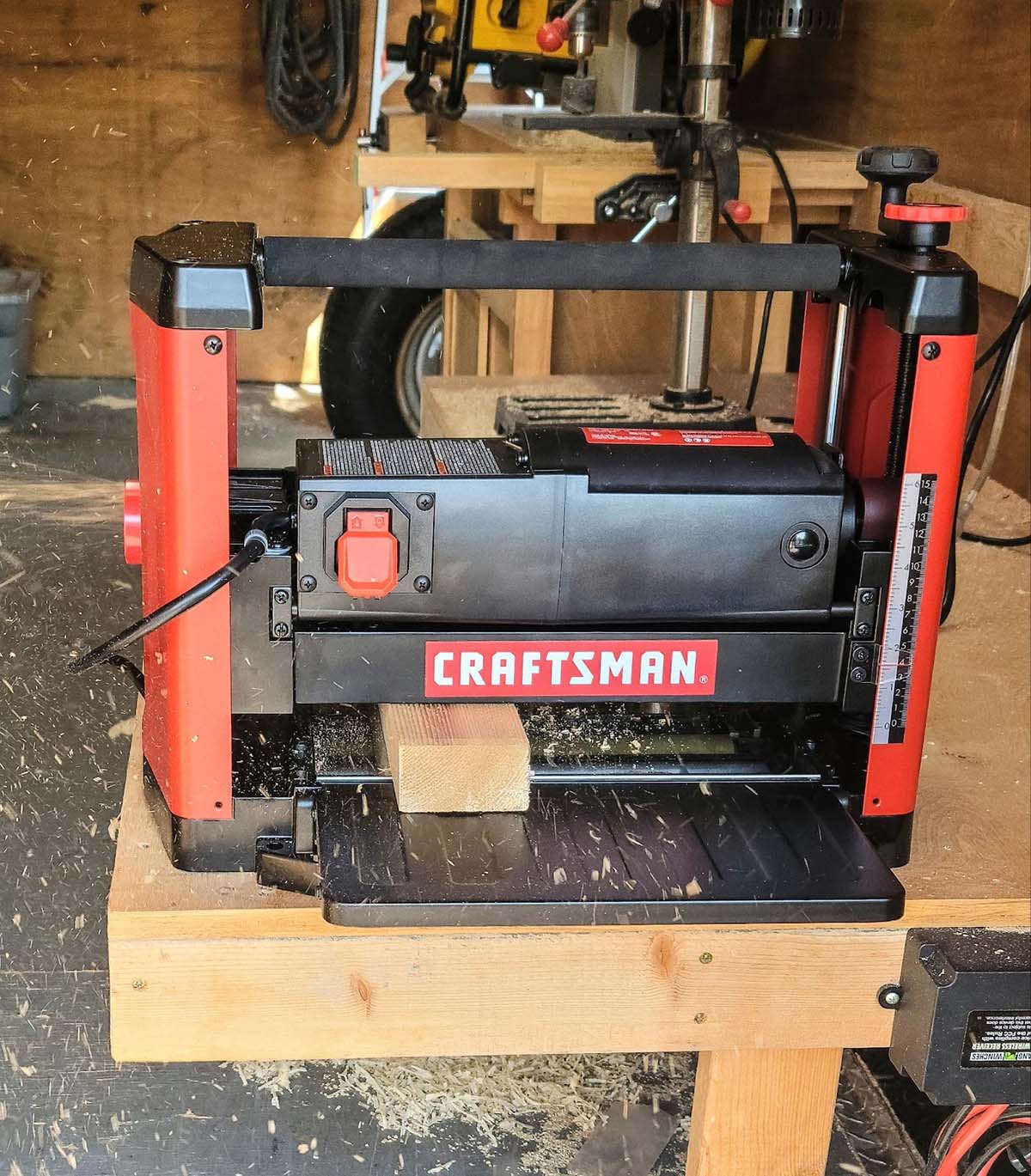
Our Top Picks
Investing in the right benchtop planer is important for anyone who’s into woodworking. We put the top DIY and professional models through their paces and scrutinized each. The models that earned a spot in our lineup are among the best benchtop thickness planers available today, so one is likely to find a favored place in your workshop.
Best Overall
Dewalt 13-Inch 3-Knife 2-Speed Thickness Planer
See ItOur Ratings: Ease of Use 5/5; Performance 5/5; Board Capacity 5/5; Dust 4.7/5; Value 4.8/5
Product Specs
- Motor: 15 amp
- Blades: 3 straight knife blades
- Allowance: 13 inches wide and 6 inches high
Pros
- Shaves up to ⅛ inch per pass; 2 feed speeds included
- Built-in infeed and outfeed tables, plus an extra set of knives
- Fan-assisted chip ejection vacuums chip off cutterhead and exhausts it out of machine
Cons
- Quite a bit more expensive than our other picks
- Unhandy location for chip-ejection port
Those in the market for a high-capacity planer with plenty of features will want to consider the DeWalt 13-inch thickness planer. This benchtop planer can handle materials up to a 13-inch width capacity with a 6-inch length. This heavy planer weighs in at 92 pounds, and we found its weight was beneficial in keeping it in one place during operation. We put the planer on a reinforced work surface—this tool is too heavy for most portable-type bolt holes in the base.
We’re familiar with the high quality of many DeWalt tools, and this thickness planer is no exception. It boasts a powerful 15-amp motor and a three-blade cutterhead that spins at 10,000 revolutions per minute (rpm). It can be set to plane off as much as ⅛ inch of wood in a single pass. It comes standard with front and back stainless steel infeed and outfeed tables that help support the boards as they pass through the planer. A unique option on this benchtop planer is the ability to adjust the feed speed. A lever on the front let us select either 96 or 179 cuts per inch (cpi). At 95 cpi, the DeWalt planer pulled the boards through twice as quickly as when we selected 179 cpi, but the surface was slightly rougher. Interestingly, even at 96 cpi, we found the boards were smooth enough for most high-end woodworking. At 179 cpi, they felt as though they’d already been sanded. This is in large part because of the three straight blades in the DeWalt planer. Most of today’s planers have only two blades.
We planed dozens of boards with the DeWalt model: softwoods, including pine and cedar; and hardwoods, including ash, oak, and walnut. The DeWalt planed all of them smoothly, and we found little to no snipe on any of the boards. We attributed this benefit to an extension outfeed table that helps support the boards as they exit the machine. The benchtop planer has a fan-assisted chip-ejection port on the back of the machine that we connected to our dust-collection system. The chip-ejection fan is so powerful that when we walked behind the machine to grab the board as it passed through, the chips stung when they hit us. Impressive! And slightly painful. The downside is that the chip-ejection port is positioned just over the outfeed table, so the hose on our dust-collection system kept dipping down and interfering with the boards as they exited the planer. Our makeshift fix was to tie the hose up to keep it out of the way.
We believe this top-notch planer would be an asset in any DIYer or woodcrafter’s shop. It’s powerful, the feed speed is adjustable, and the ruler gauge is accurate. (We measured the planed boards with calipers to determine gauge accuracy.) The model comes with a “bump” on/off switch in the front that allowed us to shut the machine down simply by bumping the switch with our hand or arm. This is a safety feature in the event something goes wrong—such as a board getting caught sideways or an article of clothing getting drawn into the machine. Just a bump, and the DeWalt shuts down. Get the DeWalt benchtop planer at Amazon, Lowe’s, or The Home Depot.
Best Bang for the Buck
Craftsman 15 Amp Benchtop Thickness Planer
See ItOur Ratings: Ease of Use 4.5/5; Performance 4/5; Board Capacity 4.5/5; Dust 4.5/5; Value 4.8/5
Product Specs
- Motor: 15 amp
- Blades: 2 high-carbon steel double-edged reversible knives
- Allowance: 12 ¼ inches wide and 6 inches high
Pros
- 8,000 rpm cutterhead speed provides up to 16,000 cuts per minute
- Fold-up infeed and outfeed tables for easier storage
- Built-in dust-collection port for a cleaner workspace
Cons
- Requires bolting to workbench to prevent movement
- Creates small snipe on last 2 inches of board
As a reasonably priced wood planer that can handle up to 12.25-inch-wide boards, the Craftsman benchtop thickness planer is worth a look. The manufacturer has a long and reputable history of making durable tools and quality machines. At just 61.8 pounds, the Craftsman was a bit easier to lift and position on the work surface, but we noted that this lighter weight resulted in the machine “walking” just a bit when we planed large hardwood boards. Fortunately, there’s a simple solution: Just bolt it down to a workbench. The benchtop planer has a 15-amp motor that produces cutter speeds up to 8,000 rpm. Thanks to its two-blade straight-knife cutter design, it provides 16,000 cuts per minute, which we found to be more than adequate for most small cabinetry and furniture-building projects.
This Craftsman planer accepts boards up to 6 inches long, and it comes with a safety bump on/off switch on the front and a precision gauge along the side for selecting the correct cutting height. The planer shaves removes up to ⅛ inch. The Craftsman doesn’t offer a feed-speed adjustment, and we couldn’t find a feed-speed rating listed in the owner’s manual, but we used a stopwatch and came up with an approximate feed speed of 23 feet per minute. The planed boards were smooth enough that a light sanding would remove any residual grain roughness, but we did find a 2-inch snipe at the end of every board we planed. This is a common occurrence with planers; we didn’t deduct any points—just be aware that it occurs and plan to plane boards a couple of inches longer than the desired finished length. Those who won’t use a benchtop planer often and are a bit short on space might appreciate the fold-up infeed and outfeed tables that make storage a bit easier. We found this handy for setting the planer out of the way under a table.
Get the Craftsman benchtop planer at Lowe’s, Amazon, or Craftsman.
Upgrade Pick
Makita 2012NB 12-Inch Portable Planer
See ItOur Ratings: Ease of Use 4.7/5; Performance 4.7/5; Board Capacity 5/5; Dust 3/5; Value 4.5/5
Product Specs
- Motor: 15 amp
- Blades: 2 straight knife blades
- Allowance: 12 inches wide and 6 3/32 inches thick
Pros
- Makita’s exclusive Interna-Lok automated head clamp eliminates snipe and improves board stability
- Very stable for improved planing performance
- Quieter operation than competing models; registers only 83 decibels
Cons
- Dust collector port is sold separately
- One of the more expensive benchtop planer models on our list
Anyone looking for a portable planer that provides extra maximum thickness—for timber frame mailbox posts, say, or heavy furniture—will want to check out the 2012NB 12-inch planer from Makita. This machine has an above-average 6 3/32-inch maximum thickness capacity, which is slightly higher than the others we tested. The real draw of the Makita 2012NB comes in its stability and quiet operation. It’s remarkably stable for its relatively light weight of just 61.9 pounds. It didn’t walk or shift, even when we ran large hardwood boards through, making it one of the best portable thickness planers that do need to be bolted down. Plus, though hearing protection is still recommended, it’s noticeably quieter than the other models we tested—a sound output of 83 decibels, according to the manufacturer. The other planers don’t list the decibel factor but were, in our estimation, about a quarter louder than the Makita.
This planer has a 15-amp motor that produces 8,500 rpm on the cutterhead. It has two straight-knife cutters and a cutting depth of up to 1/8 inch. The Interna-Lok head clamp holds the board in place better than standard rollers, and we didn’t find any snipe on boards shorter than 4 feet long. As we planed longer boards, however, we began to see a faint snipe line on the last 2 inches of the board. By supporting the end of the board as it came out, we could eliminate the snipe line. Whether we removed 1/8 inch or 1/64 inch, the planed boards came out very smooth and would need only light sanding for most projects.
The feed speed is not adjustable, but the Makita makes quick work of pulling the boards through—the manufacturer lists the feed rate as 27.9 feet per minute, which seemed about right in our tests, but keep in mind that heavy boards typically move slightly slower than small lightweight boards. The planer comes with a bump power switch and a precision gauge, and although it doesn’t have a built-in dust-collection port, an attachment is sold separately.
Get the Makita benchtop planer at Amazon, The Home Depot, or Ace Tool.
Best for Rough Wood
Wen 12.5-Inch 2-Blade Benchtop Thickness Planer
See ItOur Ratings: Ease of Use 4.5/5; Performance 4/5; Board Capacity 4.5/5; Dust 4/5; Value 4.2/5
Product Specs
- Motor: 15 amp
- Blades: 2 straight blades
- Allowance: 12½ inches wide and 6 inches high
Pros
- Can adjust the depth from 0 to ⅛ inch with each pass
- Leaves wood smooth and includes a dust port
- Well suited for resurfacing rough lumber
Cons
- We noticed some snipe on the last couple of inches of the board
- Machine requires bolting down to keep from moving
Those looking for a robust planer for resurfacing rough or reclaimed lumber, or smoothing and thinning new lumber, may want to consider the Wen benchtop thickness planer. We found this model well suited to removing up to 1/8 inch of wood from the surface of boards up to 12.5 inches wide. In addition, it handles board heights of up to 6 inches. With 10,000 rpm, this planer offers plenty of power for smoothing rough wood. Its two straight blades make up to 20,000 cuts per minute. The height adjustment handle on this planer is slightly smaller than some—and it’s located at the top of the machine—but it still follows the same general rule of one turn equals 1/16 inch.
When we planed the first board on the Wen and then measured it for precision, we found it was 1/32 inch too high. That may not sound like a lot, but it’s substantial when it comes to creating uniform board height for a project. Fortunately, the gauge is adjustable, so we used a small screwdriver to adjust it 1/32 inch and then ran another board through. Perfect! Most planer gauges come preset, but occasionally one can be slightly off. Just adjust it and try again. We did notice some snipe at the last couple of inches, so we recommend planing boards at least 2 inches longer than needed. There’s no feed-speed adjustment, but according to the manufacturer, the planer moves boards as quickly as 26 feet per minute, depending on size.
At just 55.6 pounds, the Wen is slightly on the light side, and we needed to bolt it down to keep it from moving during operation. It comes with a conveniently located port that we attached to our dust-collection system. We did notice some small chips remained on the feed plate after planing. This isn’t a big issue, but the ejection fan didn’t seem to eject all of them through the port. If necessary, this can be remedied by just blowing the chips out before inserting a new board. Like many other quality planers, the Wen has a bump-type on/off switch for added safety.
Get the Wen benchtop planer at Lowe’s, Amazon, or The Home Depot.
Best Light-Duty
PowerTec PL1252 12.5-Inch Planer
See ItOur Ratings: Ease of Use 4/5; Performance 4/5; Board Capacity 4/5; Dust 3/5; Value 4.2/5
Product Specs
- Motor: 15 amp
- Blades: 2 straight cutting knives
- Allowance: 12½ inches wide and 6 inches high
Pros
- Foldable infeed and outfeed tables for easier storage
- Heavy-duty anti-wobble base that’s ultra sturdy
- Side-mounted carrying handles included for simple transport
- One of the more affordable options on the market
Cons
- Limited surface removal; maximum depth of cut of 3/32 inch
- No dust-collector port, but shoppers can purchase one separately
Aggressive planers aren’t for everyone, and the PowerTec planer is worth a look for those in the market for a lighter-duty model. This machine has a 12 1/2-inch width capacity and a 6-inch maximum thickness. When we tested the PowerTec, we found it removed thin layers very well, but it’s not suitable for more aggressive wood removal. This planer is made to remove a maximum of 3/32 inches from boards that are 5 inches wide or less. When planing boards wider than 5 inches, we had to adjust the gauge to remove just 1/32 of an inch or less. For many, this won’t be an issue because wood crafters often need only remove a sliver of the board’s surface.
The downside is that the user must know to scale down the depth of the cut with boards wider than 5 inches. Um…we didn’t know, so we fed a 10-inch-wide board into the PowerTec multiple times, only to overheat the machine and trip its internal circuit breaker. At that point, we decided to read the operating instructions and we found the caveat. When the machine cooled down, we started testing again, following the planing depth instructions. No problem—the PowerTec easily handled the boards. The PowerTec didn’t give us much in the way of pesky snipe at the board ends. A few of the larger boards bore an almost imperceptible snipe line, which we could smooth out with light sanding.
This planer’s 15-amp motor produces up to 9,400 rpm at the two-blade cutterhead, and its intake and outtake tables fold upward for easy storage. It weighs in at 63.4 pounds, and the only time it moved during operation was when we were planing too much thickness from boards wider than 5 inches. When we stuck to the manufacturer’s limits, the machine held firm. The only other drawback we found is the lack of a built-in dust collection port, though one can be purchased separately.
Get the PowerTec benchtop planer at The Home Depot, Amazon, or XDC Depot.
Also Consider
Ridgid 13-Inch Thickness Planer w/ 3-Blade Cutterhead
See ItOur Ratings: Ease of Use 4/5; Performance 4/5; Board Capacity 4.5/5; Dust 4/5; Value 4.3/5
Product Specs
- Motor: 15 amp
- Blades: 3 straight blades
- Allowance: 13 inches wide and 6⅛ inches high
Pros
- Has a maximum depth cut of up to 1/8 inch
- Ind-I-Cut gauge instantly measures cutting depth before each pass
- Handles large and small boards as well as hardwoods and softwoods with ease
Cons
- We noticed a small amount of snipe at board ends
Besides our Best Overall pick, the Ridgid 13-inch planer is the only other three-blade planer we tested, and it impressed us on many fronts. It features a maximum cut allowance of ⅛ inch and accepts boards up to 13 inches wide and 6⅛ inches high. In addition to its gauge, which is easy to read and comes with 1/64-inch increments, it also features a separate Ind-I-Cut gauge on the front of the planer that allowed us to see exactly how much wood we were removing in a pass. We found this feature valuable, especially because tiny 1/64-inch increments can be challenging to see. The Ind-I-Cut acted like a magnifying glass to let us see the amount of wood we were removing as we planned. The Ridgid planer features 9,000 rpm at the cutterhead, which translates into 27,000 cuts per minute, an enviable number of cuts in the world of planers.
We tested it on dozens of boards, both hardwood and softwood species, large and small, and it powered through all of them without bogging down. We did get a little snipe at the ends of the boards, but given how much power—and how smooth—the Ridgid performs, it was a minor downside. We found that supporting the ejected boards helped lessen, but didn’t fully eliminate, the snipe. As with the other planers we tested, we appreciated the large bump on/off switch for safety. At 73 pounds, the Ridgid remained firmly rooted while we planed board after board. It features a chip-ejector port that connects to a standard dust-collection system.
This planer is suitable for removing rough, weathered surface grain as well as fine-tuning hardwood for furniture and cabinetry projects. Its third blade and its Ind-I-Cut gauge pretty much puts it in a class by itself. Those who want an aggressive three-blade planer but don’t want to spend the extra bucks may wish to consider the Ridgid planer. We were delighted with its performance.
Get the Ridgid benchtop planer at The Home Depot, Amazon, or Ridgid.
Jump to Our Top Picks
What to Consider When Choosing a Benchtop Planer
Benchtop planers, also known as “thickness planers” because they reduce the thickness of a board, have rotating blades inside that shave off a thin layer of wood. Those who are interested in owning one but don’t have a lot of experience with this powerful tool will want to keep the following factors and features in mind when shopping.
Motor
A benchtop planer’s motor needs enough power to get the job done. How much is enough depends on specific projects.
If users work primarily with softer woods such as pine, cedar, and fir—for building country-style furniture or birdhouses, for example—a motor in the 1- to 1½-horsepower (hp) range might suit them well. A thickness planer doesn’t need much juice to shave a layer off the top of these materials.
However, if users are into high-end joinery or cabinetry, they’ll probably work with species such as oak, maple, and even walnut. These hard materials will require more from a planer to shave them down, so they’ll want to look for a 2 hp tool.
Perhaps even more important than horsepower is a planer’s motor rating—choose one with a 15-amp motor. Planers draw a lot of electricity, and Sanders suggests getting a powerful one. “Look for at least a 15-amp motor with multiple speed options,” he advises. A 15-amp motor helps ensure the machine can handle the task without breaking down. Smaller-amperage motors don’t have the power necessary for planing wood.
Blades
Thickness planer blades (or knives) come in different styles. “The three main options are straight knife, helical, and spiral/helix,” Sanders says. “The straight knife is the most affordable but produces more tear-out. Helical and spiral cut cleaner but cost more upfront. Spiral cutter heads are generally regarded as producing the best finish.”
Blades vary on straight-knife cutter models. Some are reversible, so when they become dull, the user can turn them over and use the other side. Others have only one sharp edge, but they can be manually sharpened with a standard sharpening stone, just like a kitchen knife. Reversible knives are disposable, meant to be tossed out after both sides wear down.
All the planers we tested came with cutterheads designed to accept straight blades.
Cutting Depth
Cutting depth refers to how much material a wood planer can remove in one pass. Generally speaking, the more powerful the planer, the more material it can remove in one pass and the larger the depth of cut.
Planers that can shave off up to ⅛ inch at a time are good for removing the surface of rough or weathered wood. Removing that much depth at once, however, isn’t always optimal. Generally, it’s usually best for the board—and for the machine—to err on the side of caution and plane off thinner amounts. The more wood a planer removes in a pass, the harder it must work, which can lead to overheating if the user is planing a lot of boards.
Many woodworkers will find little need to remove more than 1/16 inch per pass, and for fine-tuning boards, they will remove even less—1/32 or 1/64 inch. Don’t pass up a planer just because it doesn’t remove ⅛ inch per pass. It’s easy enough to set the planer at 1/16 inch and then run it through twice.
Allowance
A thickness planer’s allowance indicates the widest (and tallest) board that can be passed through the tool. Manufacturers label most planers with ranges between 12 inches and 13 inches (plenty for most woodworking hobbyists), but this metric doesn’t tell the whole story.
For example, a 12-inch planer can handle a board 12 inches in width capacity, but that does not say how thick (i.e., tall) a piece of wood the planer can handle. This metric is quite helpful, so look for a model that can handle materials as thick as 5 or 6 inches to get the most use out of a wood planer.
Snipe
Snipe refers to an undesirable line, which can sometimes be very noticeable, left on the top end of a board after planing. It’s the result of the wood planer removing more wood at the end of the board. As the end of the board clears the first set of rollers, gravity tends to pull the board downward, which puts pressure on the other end. When this happens, the cutterhead blades may remove slightly more wood at the very end. A snipe looks like a thin dip, usually less than 1/16 inch, located along the last couple inches of the board.
“Longer infeed and outfeed tables help support boards and minimize snipe,” Sanders explains. He adds that “36-inch to 44-inch tables are good for a benchtop planer.” Just make sure they fold down for storage. Snipe may be unavoidable to some degree, but some benchtop thickness planers do better than others at minimizing its effect. A good way to avoid snipe appearing on a finished product is to leave boards longer than necessary by an inch or so when planning and then cut the sniped ends off before using the board for your project.
Gauge and Depth Stop
Shaving the intended amount of wood off your workpieces can be tedious. Bringing a hardwood board from a 1-inch thickness to a ⅝-inch thickness, for example, could take five or six passes. The user could measure the board’s thickness before each pass and adjust the cutterhead using a tape measure or a combination square, but that’s time-consuming.
Many of today’s benchtop planers have a built-in gauge that looks like a ruler attached to the side of the intake slot. The gauge will indicate the proposed board thickness as the user raises or lowers the planer’s carriage (the top part of the tool that moves up and down) via a hand crank.
Planer gauges typically show measurements in 1/16-inch increments, but some show measurements in 1/64-inch increments. Some experienced woodworkers don’t use the gauge at all but rather determine cutting depth with the tool’s hand crank. On a planer, a complete revolution of its hand crank equals 1/16 inch. Half a crank equals 1/32 inch, and a quarter of a crank equals 1/64 inch.
A depth stop is a feature that keeps the user from shaving off more than the machine’s maximum cutting depth. For example, if the planer has a maximum cutting depth of ⅛ inch, the depth stop will prevent the user from inserting any board more than ⅛ inch thicker than the thickness chosen on the gauge (ruler). The board simply will not go into the slot. In this way, users needn’t worry about taking off more than the maximum cutting depth because the depth stop won’t allow it.
Dust Collection
Thickness planers create a good deal of dust and wood chips. These machines rip off and spit out tiny pieces of wood, and the floor under a thickness planer will resemble a child’s sandbox after only a few boards.
Many of today’s benchtop planers have dust ports that attach to a shop vacuum or dust-collection system to minimize the mess. These collection systems also do a good job of removing the dust from the machine before it can settle in the cutterhead, helping to maintain its usable life and cutting speed.
Speed
Different speeds apply to a benchtop planer: cutterhead speed, cutting speed, and feed speed.
- Cutterhead speed refers to how quickly the motor spins the cutterhead, measured in rpm. The best benchtop thickness planers use pulleys and belts from the motor to spin the cutterhead. Look for speeds above 8,000 rpm for best results.
- Cutting speed refers to how many times the blades strike the board’s surface per minute. For instance, a cutterhead speed of 8,000 rpm on a two-blade cutterhead will produce a cutting speed of 16,000 cuts per minute. On a three-blade planer, that increases to 24,000 cuts per minute. The higher the cutterhead rpm, the smoother the results.
- Feed speed refers to the rate the board passes through the thickness planer. Some high-end planers—like our Best Overall pick—allow users to increase or reduce feed speed, an adjustment that changes how many cuts per inch the blade makes, but the majority have a set feed speed that isn’t adjustable. The higher the feed speed, the quicker the board moves, but the lower the cuts per inch, causing a rougher finished result. The lower the speed, the smoother the board will come out.
FAQs
Alongside other popular power tools, such as band saws, table saws, and wood lathes, benchtop thickness planers are a boon in a woodworking shop. If this is your first planer, you will probably have questions about the tool’s best use and operation. Ahead are answers to some of the most common questions about benchtop planers. If you still want more information about your benchtop planer, refer to the user’s manual or contact the manufacturer.
Q. What is a bench planer used for?
Benchtop planers reduce the thickness of a board. Woodcrafters can use them to create consistent thicknesses on several boards for woodworking purposes or to uncover the beauty hidden underneath reclaimed wood.
Q. How is a benchtop planer used?
With the benchtop planer turned off, place a board in the intake feed slot. Lower the roller carriage (the top part of the planer) using the hand crank until it just touches the board. This is the starting point. Remove the board, and then use the crank to lower the roller carriage to the desired cutting depth (typically between 1/64 and ⅛ inch). The woodworker can use the ruler gauge to determine the cutting depth or use the crank rule of thumb—one full revolution of the crank equals 1/16 inch. Once the cutting height is decided, turn the planer on and slowly feed the board into the intake slot. The planer will do the rest—users don’t have to push the board.
Q. What is the difference between a jointer and a planer?
Planers reduce the thickness of a board by shaving a uniform amount of wood off its surface. Jointers make the board flat by shaving away only the high spots, not the entire surface, as a planer does.
Q. How much does a planer weigh?
Wood planers can be some of the heaviest tools in your shop. Benchtop planers weigh an average of between 60 and 100 pounds, so it may be wise to keep it on a benchtop rather than moving it around.
Meet the Tester
Glenda Taylor is a product tester and writer specializing in the construction, remodeling, and real estate industries. She and her husband own a general contracting company, and Taylor is experienced in both residential and commercial building applications. She tests a wide range of power tools as well as other home improvement, household, and lawn-and-garden products.
